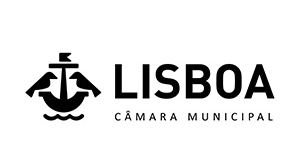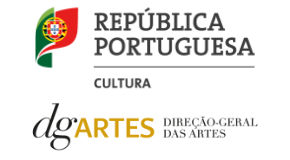 This Angolan poet and musician has captivated European audiences, but the journey has been long and hard. In Lisbon, he was able to show us the rich cultural heritage of sounds emerging from Africa which had hitherto been hidden. He drew on his experience and on sounds from Angola and meshed them with the latest sounds being played in Europe. His music speaks of new trends and of being a global citizen. These are some of the secrets behind his original sound.
This Angolan poet and musician has captivated European audiences, but the journey has been long and hard. In Lisbon, he was able to show us the rich cultural heritage of sounds emerging from Africa which had hitherto been hidden. He drew on his experience and on sounds from Angola and meshed them with the latest sounds being played in Europe. His music speaks of new trends and of being a global citizen. These are some of the secrets behind his original sound.
22.07.2010 | by Marta Lança
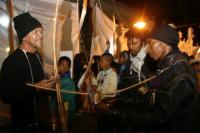 ...I am skeptical of claims made on behalf of populations, particularly in culturally disenfranchised and economically impoverished locations such as New Orleans or Haiti. I also do think that there can be legitimate concerns about the neo-colonial nature of the worldwide biennial trend, which tends to impose a Western cultural model as mainstream in non-Western locales the artistic practices and cultural heritage of which often belie the notion that contemporary art is a globally shared cultural value.
...I am skeptical of claims made on behalf of populations, particularly in culturally disenfranchised and economically impoverished locations such as New Orleans or Haiti. I also do think that there can be legitimate concerns about the neo-colonial nature of the worldwide biennial trend, which tends to impose a Western cultural model as mainstream in non-Western locales the artistic practices and cultural heritage of which often belie the notion that contemporary art is a globally shared cultural value.
22.07.2010 | by Claire Tancons
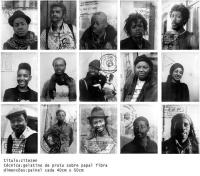 Délio Jasse work can be interpreted under the somewhat complex view of the post colonial speeches, in the sense that his images emanate a quality of alterity, which gives them identity. However this simplification can be limiting if it becomes dissonant with the artistic speech where his images belong, obviously.
Délio Jasse work can be interpreted under the somewhat complex view of the post colonial speeches, in the sense that his images emanate a quality of alterity, which gives them identity. However this simplification can be limiting if it becomes dissonant with the artistic speech where his images belong, obviously.
08.07.2010 | by Hugo Dinis
 José Cabral came to this collective history in a unique way, having trained with his father amateur photographer and filmmaker — he also had a homonymous grandfather, on his father’s side, who was a governor (1910-1938) and who had a park named after him in the old capital Lourenço Marques (Continuadores Park, today). He started in cinematography and he joined his experience as a news photographer to documental programmes of a less urgent nature. Later, he was probably the first to distance himself from the routines of journalism, and he made that challenge very clear with the choice of works in display in the Iluminando Vidas exhibit: instead of war, misery, victims, ruins and promises of reconstruction, that can still be seen yet another face for exoticism, he showed feminine nudes without any ethnographical pretext.
José Cabral came to this collective history in a unique way, having trained with his father amateur photographer and filmmaker — he also had a homonymous grandfather, on his father’s side, who was a governor (1910-1938) and who had a park named after him in the old capital Lourenço Marques (Continuadores Park, today). He started in cinematography and he joined his experience as a news photographer to documental programmes of a less urgent nature. Later, he was probably the first to distance himself from the routines of journalism, and he made that challenge very clear with the choice of works in display in the Iluminando Vidas exhibit: instead of war, misery, victims, ruins and promises of reconstruction, that can still be seen yet another face for exoticism, he showed feminine nudes without any ethnographical pretext.
28.05.2010 | by Alexandre Pomar
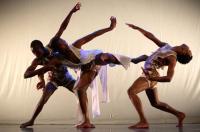 Gregory Maqoma, South-African dancer and choreographer, uses his origins to build his identity as an artist. The performer came to Luanda to present 'Beautiful Me', a show in which he is the only participant, and that reflects some of his concerns about south-african society and the political power as a whole, around the world
Gregory Maqoma, South-African dancer and choreographer, uses his origins to build his identity as an artist. The performer came to Luanda to present 'Beautiful Me', a show in which he is the only participant, and that reflects some of his concerns about south-african society and the political power as a whole, around the world
24.05.2010 | by Joana Simões Piedade
 Subjects like discrimination – by skin color, social position or gender- all found an important place in Ingrid’s work. Gradually she has been focusing on conflict issues and the reasons why we live in violence.
In addition to her interest in subjects like the war and the media she is also very interested in the role of women, their strength and their projection in the world. Regarding that she stats “we can’t run away from our body. At the beginning it was not an easy thing to do but I acquired consciousness that my black woman’s body is, by itself, a statement. Then I started to work on this matter”.
Subjects like discrimination – by skin color, social position or gender- all found an important place in Ingrid’s work. Gradually she has been focusing on conflict issues and the reasons why we live in violence.
In addition to her interest in subjects like the war and the media she is also very interested in the role of women, their strength and their projection in the world. Regarding that she stats “we can’t run away from our body. At the beginning it was not an easy thing to do but I acquired consciousness that my black woman’s body is, by itself, a statement. Then I started to work on this matter”.
22.05.2010 | by Joana Simões Piedade
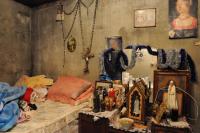 What Mónica de Miranda intends is “to create space so that the migratory and trans–national flows are seen by themselves as a diversified and multifaceted reality as a platform for creative opportunities and a place of transit for personal, social and cultural changes. "At the heart of its strategy is the principle of interculturality, which should involve a gradual and systematic promotion of spaces and processes of positive interaction, a possible generalization of relations of trust, mutual recognition, for discussion, learning and exchange.
What Mónica de Miranda intends is “to create space so that the migratory and trans–national flows are seen by themselves as a diversified and multifaceted reality as a platform for creative opportunities and a place of transit for personal, social and cultural changes. "At the heart of its strategy is the principle of interculturality, which should involve a gradual and systematic promotion of spaces and processes of positive interaction, a possible generalization of relations of trust, mutual recognition, for discussion, learning and exchange.
15.05.2010 | by José António Fernandes Dias
 The work presented by Yonamine in this exhibition speaks about the idea of erasure.
Yonamine comes from an erased country, Angola. A country which history, instead of working as a palimpsest – that is, a text over which multiple writings were produced leaving notice of those preceding them – has always worked as an erasing process. History has been erased in the name of a bigger interest. The Portuguese colonial past that Yonamine evokes with a subtle irony in the exhibition's title and in the tobacco boxes series was removed by the sudden decolonization process, which, by its turn, was erased by the war that now is being erased by peace.
The work presented by Yonamine in this exhibition speaks about the idea of erasure.
Yonamine comes from an erased country, Angola. A country which history, instead of working as a palimpsest – that is, a text over which multiple writings were produced leaving notice of those preceding them – has always worked as an erasing process. History has been erased in the name of a bigger interest. The Portuguese colonial past that Yonamine evokes with a subtle irony in the exhibition's title and in the tobacco boxes series was removed by the sudden decolonization process, which, by its turn, was erased by the war that now is being erased by peace.
14.04.2010 | by Paulo Cunha e Silva
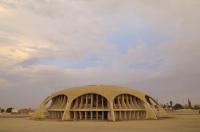 Kiluanji Kia Henda has displayed his art internationally – from Guangzhou to Cape Town, from Nairobi to Venice – which decouples his work from the exclusive legitimacy granted by Western contemporary art capitals. Another unique trait of his trajectory is that so far, his work has not been presented and sanctioned by the “small” world of its former “metropole”, Lisbon. As an Angolan artist, and therefore, from an independent country today and once a Portuguese colony, his art world’s has been extraneous to a set of cultural policies that take Portuguese-as-connection, and which rely on a closed circuit showcasing of art and its artists, traveling between ex-colonies and the ex-metropole.
Kiluanji Kia Henda has displayed his art internationally – from Guangzhou to Cape Town, from Nairobi to Venice – which decouples his work from the exclusive legitimacy granted by Western contemporary art capitals. Another unique trait of his trajectory is that so far, his work has not been presented and sanctioned by the “small” world of its former “metropole”, Lisbon. As an Angolan artist, and therefore, from an independent country today and once a Portuguese colony, his art world’s has been extraneous to a set of cultural policies that take Portuguese-as-connection, and which rely on a closed circuit showcasing of art and its artists, traveling between ex-colonies and the ex-metropole.
12.04.2010 | by Marta Mestre
 This Angolan poet and musician has captivated European audiences, but the journey has been long and hard. In Lisbon, he was able to show us the rich cultural heritage of sounds emerging from Africa which had hitherto been hidden. He drew on his experience and on sounds from Angola and meshed them with the latest sounds being played in Europe. His music speaks of new trends and of being a global citizen. These are some of the secrets behind his original sound.
This Angolan poet and musician has captivated European audiences, but the journey has been long and hard. In Lisbon, he was able to show us the rich cultural heritage of sounds emerging from Africa which had hitherto been hidden. He drew on his experience and on sounds from Angola and meshed them with the latest sounds being played in Europe. His music speaks of new trends and of being a global citizen. These are some of the secrets behind his original sound.  ...I am skeptical of claims made on behalf of populations, particularly in culturally disenfranchised and economically impoverished locations such as New Orleans or Haiti. I also do think that there can be legitimate concerns about the neo-colonial nature of the worldwide biennial trend, which tends to impose a Western cultural model as mainstream in non-Western locales the artistic practices and cultural heritage of which often belie the notion that contemporary art is a globally shared cultural value.
...I am skeptical of claims made on behalf of populations, particularly in culturally disenfranchised and economically impoverished locations such as New Orleans or Haiti. I also do think that there can be legitimate concerns about the neo-colonial nature of the worldwide biennial trend, which tends to impose a Western cultural model as mainstream in non-Western locales the artistic practices and cultural heritage of which often belie the notion that contemporary art is a globally shared cultural value.  Délio Jasse work can be interpreted under the somewhat complex view of the post colonial speeches, in the sense that his images emanate a quality of alterity, which gives them identity. However this simplification can be limiting if it becomes dissonant with the artistic speech where his images belong, obviously.
Délio Jasse work can be interpreted under the somewhat complex view of the post colonial speeches, in the sense that his images emanate a quality of alterity, which gives them identity. However this simplification can be limiting if it becomes dissonant with the artistic speech where his images belong, obviously.  José Cabral came to this collective history in a unique way, having trained with his father amateur photographer and filmmaker — he also had a homonymous grandfather, on his father’s side, who was a governor (1910-1938) and who had a park named after him in the old capital Lourenço Marques (Continuadores Park, today). He started in cinematography and he joined his experience as a news photographer to documental programmes of a less urgent nature. Later, he was probably the first to distance himself from the routines of journalism, and he made that challenge very clear with the choice of works in display in the Iluminando Vidas exhibit: instead of war, misery, victims, ruins and promises of reconstruction, that can still be seen yet another face for exoticism, he showed feminine nudes without any ethnographical pretext.
José Cabral came to this collective history in a unique way, having trained with his father amateur photographer and filmmaker — he also had a homonymous grandfather, on his father’s side, who was a governor (1910-1938) and who had a park named after him in the old capital Lourenço Marques (Continuadores Park, today). He started in cinematography and he joined his experience as a news photographer to documental programmes of a less urgent nature. Later, he was probably the first to distance himself from the routines of journalism, and he made that challenge very clear with the choice of works in display in the Iluminando Vidas exhibit: instead of war, misery, victims, ruins and promises of reconstruction, that can still be seen yet another face for exoticism, he showed feminine nudes without any ethnographical pretext.  Gregory Maqoma, South-African dancer and choreographer, uses his origins to build his identity as an artist. The performer came to Luanda to present 'Beautiful Me', a show in which he is the only participant, and that reflects some of his concerns about south-african society and the political power as a whole, around the world
Gregory Maqoma, South-African dancer and choreographer, uses his origins to build his identity as an artist. The performer came to Luanda to present 'Beautiful Me', a show in which he is the only participant, and that reflects some of his concerns about south-african society and the political power as a whole, around the world  Subjects like discrimination – by skin color, social position or gender- all found an important place in Ingrid’s work. Gradually she has been focusing on conflict issues and the reasons why we live in violence.
In addition to her interest in subjects like the war and the media she is also very interested in the role of women, their strength and their projection in the world. Regarding that she stats “we can’t run away from our body. At the beginning it was not an easy thing to do but I acquired consciousness that my black woman’s body is, by itself, a statement. Then I started to work on this matter”.
Subjects like discrimination – by skin color, social position or gender- all found an important place in Ingrid’s work. Gradually she has been focusing on conflict issues and the reasons why we live in violence.
In addition to her interest in subjects like the war and the media she is also very interested in the role of women, their strength and their projection in the world. Regarding that she stats “we can’t run away from our body. At the beginning it was not an easy thing to do but I acquired consciousness that my black woman’s body is, by itself, a statement. Then I started to work on this matter”.
 What Mónica de Miranda intends is “to create space so that the migratory and trans–national flows are seen by themselves as a diversified and multifaceted reality as a platform for creative opportunities and a place of transit for personal, social and cultural changes. "At the heart of its strategy is the principle of interculturality, which should involve a gradual and systematic promotion of spaces and processes of positive interaction, a possible generalization of relations of trust, mutual recognition, for discussion, learning and exchange.
What Mónica de Miranda intends is “to create space so that the migratory and trans–national flows are seen by themselves as a diversified and multifaceted reality as a platform for creative opportunities and a place of transit for personal, social and cultural changes. "At the heart of its strategy is the principle of interculturality, which should involve a gradual and systematic promotion of spaces and processes of positive interaction, a possible generalization of relations of trust, mutual recognition, for discussion, learning and exchange.  The work presented by Yonamine in this exhibition speaks about the idea of erasure.
Yonamine comes from an erased country, Angola. A country which history, instead of working as a palimpsest – that is, a text over which multiple writings were produced leaving notice of those preceding them – has always worked as an erasing process. History has been erased in the name of a bigger interest. The Portuguese colonial past that Yonamine evokes with a subtle irony in the exhibition's title and in the tobacco boxes series was removed by the sudden decolonization process, which, by its turn, was erased by the war that now is being erased by peace.
The work presented by Yonamine in this exhibition speaks about the idea of erasure.
Yonamine comes from an erased country, Angola. A country which history, instead of working as a palimpsest – that is, a text over which multiple writings were produced leaving notice of those preceding them – has always worked as an erasing process. History has been erased in the name of a bigger interest. The Portuguese colonial past that Yonamine evokes with a subtle irony in the exhibition's title and in the tobacco boxes series was removed by the sudden decolonization process, which, by its turn, was erased by the war that now is being erased by peace.  Kiluanji Kia Henda has displayed his art internationally – from Guangzhou to Cape Town, from Nairobi to Venice – which decouples his work from the exclusive legitimacy granted by Western contemporary art capitals. Another unique trait of his trajectory is that so far, his work has not been presented and sanctioned by the “small” world of its former “metropole”, Lisbon. As an Angolan artist, and therefore, from an independent country today and once a Portuguese colony, his art world’s has been extraneous to a set of cultural policies that take Portuguese-as-connection, and which rely on a closed circuit showcasing of art and its artists, traveling between ex-colonies and the ex-metropole.
Kiluanji Kia Henda has displayed his art internationally – from Guangzhou to Cape Town, from Nairobi to Venice – which decouples his work from the exclusive legitimacy granted by Western contemporary art capitals. Another unique trait of his trajectory is that so far, his work has not been presented and sanctioned by the “small” world of its former “metropole”, Lisbon. As an Angolan artist, and therefore, from an independent country today and once a Portuguese colony, his art world’s has been extraneous to a set of cultural policies that take Portuguese-as-connection, and which rely on a closed circuit showcasing of art and its artists, traveling between ex-colonies and the ex-metropole. 